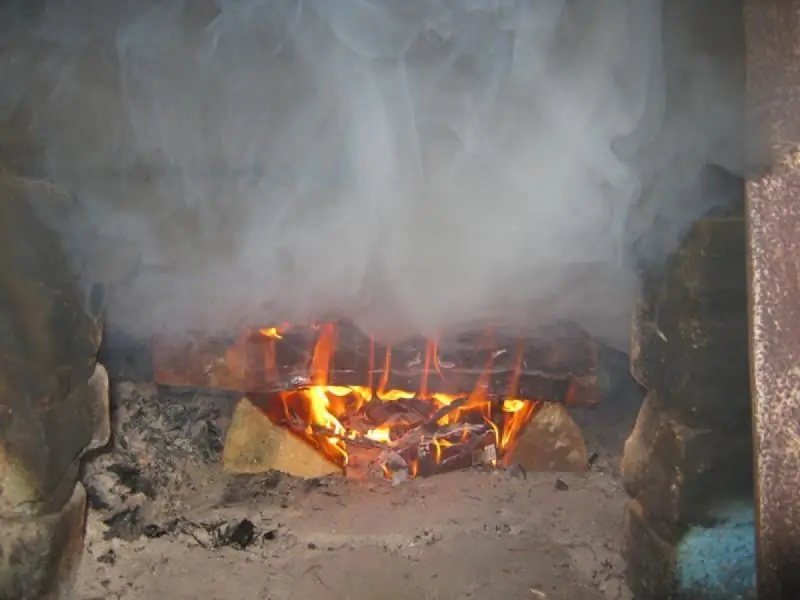
Table of contents:
- Author Bailey Albertson [email protected].
- Public 2024-01-17 22:26.
- Last modified 2025-06-01 07:32.
Draft in the chimney, the reasons for its deterioration and how to strengthen it yourself

Efficient operation of the heating system is the main condition for comfortable living in a country house. And it depends on the quality of the flue ducts. Interruptions in their work greatly complicate living in the house. In such cases, it is important to correctly establish the cause and take measures to eliminate the deficiencies.
Content
-
1 Optimization of draft in the chimney of stoves
-
1.1 Influence of various factors on traction
1.1.1 Video: how to increase chimney draft
- 1.2 How to measure thrust
-
-
2 What to do in case of reverse thrust
-
2.1 Reasons for pulling over
2.1.1 Photo Gallery: Soot Prevention Products
-
-
3 How to increase chimney draft
- 3.1 Changes to the chimney design
- 3.2 Use of deflectors
- 3.3 Electric smoke exhausters
-
3.4 DIY chimney draft amplifier
- 3.4.1 Photo gallery: which deflectors can be made by hand
- 3.4.2 Step-by-step instructions for making a deflector
- 3.4.3 Video: making a deflector with your own hands
- 4 User Reviews
Optimization of draft in the chimney of stoves
Draft is the natural movement of air in the chimney duct associated with the difference in pressure inside the building and in the external space. It is due to the efficient combustion of fuel in the furnace and the removal of combustion products from the living area. Excessive draft leads to excessive consumption of fuel, insufficient draft worsens living conditions and can create a dangerous situation for people present in the house. Under certain conditions, the state of traction can lead to tragic consequences, causing a fire.
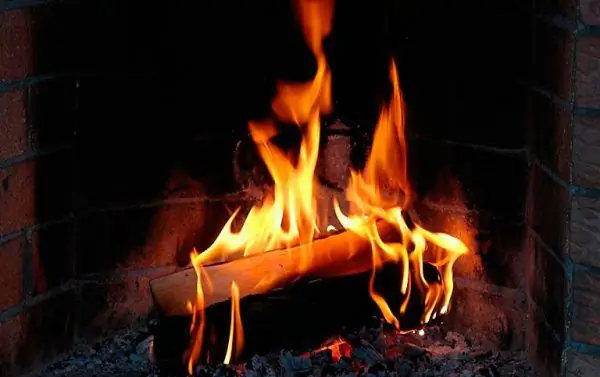
If the draft is normal, then all combustion products are discharged into the atmosphere without disturbing the usual coziness and comfort in the house.
Having acquired the skills of traction control, it is possible to effectively control the combustion of fuel to create comfortable conditions in rooms with its rational use.
Influence of various factors on traction
Any reason that affects the air pressure in the room will affect the amount of draft in the chimney. They can be conditionally divided into three groups:
Indoor conditions in a residential area:
- The material used for the construction of the living space. Natural materials "breathe", artificial ones do not. Natural components also oxidize some of the oxygen, reducing its content in the air and slowing down the combustion process.
- The temperature inside the dwelling and the total volume of rooms associated with the blowing of the combustion device. The lowered temperature reduces the activity of oxygen in the air, and a large volume of rooms reduces the rate of heating of the air in them.
- The number of people living in the house. The presence of other devices that consume oxygen, such as heaters, heat guns, and others.
- The regularity of airing the room and the presence of drafts in the house. For example, when replacing ordinary windows with double-glazed windows, the thrust may decrease due to the higher tightness of the latter.
External factors:
- Temperature and humidity. Damp cold air is heavier and takes longer to warm up, "clamping" the draft in the pipe.
- The value of the atmospheric pressure. The higher it is, the worse the traction.
- The presence and activity of ascending convection currents. They help increase traction.
- Cold air inversion from top to bottom. It has the opposite effect, reducing the draft in the chimney.
-
Wind direction and strength. If the pipe head is not equipped with a deflector, the wind can "pinch" the draft in the pipe.

Wind support If there are tall buildings or trees near the chimney, the wind can interfere with the exit of flue gases up to the creation of reverse draft.
The combination of the impact of these factors has a significant impact on the amount of thrust. Given the constant change in each of them during the day, you need to constantly monitor the combustion of fuel in the furnace.
Influence of design factors:
- Chimney location - external or internal. The external (wall) chimney heats up more slowly.
- Length and presence of turns. Each deviation of the chimney from the vertical reduces the air flow rate in the chimney, while the draft decreases.
- The quality of the inner surface of the chimney: the smoother the surface, the better it works. Roughness reduces the air velocity.
-
Chimney height and location on the roof of the house. This factor is associated with the dynamics of the movement of air flows, depending on the shape of the roof. High pressure zones can form, adversely affecting the thrust value if the pipe is low.

Chimney height Insufficient chimney height can lead to a decrease in draft
- The shape of the channel is ideally round or oval, a square chimney works worse, and even worse - a rectangular one. The air in the chimney is twisted in a spiral, stagnant zones are formed in the corners of the rectangular channel, slowing down the speed of the entire flow - the draft deteriorates.
- The degree of insulation of the walls of the outlet channel. Hot air is lighter than cold air. Heat loss through the non-insulated chimney walls leads to cooling and a decrease in the speed of the furnace gases.
It is difficult to influence the design factors when it comes to a ready-made chimney system. External factors cannot be controlled in any way, but you can adapt to their influence and even use them to your advantage. The influence of the internal conditions depends only on the efficiency of the user with the heating device. By using them wisely, you can adapt to any circumstances and effectively manage the indoor climate, using fuel rationally.
Video: how to increase chimney draft
How to measure thrust
Traditionally, the chimney draft is measured with a wind speed meter - an anemometer. Its disadvantage is that more or less reliable readings of the device can be obtained at a speed of air movement of at least one meter per second.
More accurate instruments have now been developed and produced. But their cost is such that only organizations or professional chimney sweeps can afford it. It ranges from $ 700.
In domestic conditions, the presence and direction of traction can be established in simpler ways.
-
Bring a strip of toilet paper to the blower. It will deviate from the vertical in accordance with the direction of the air flow. Before checking, you need to open the gate valve. By the same principle, the thrust can be checked by the deflection of the flame of a candle or match.

Checking the draft in the chimney Before firing up the stove, you need to check the draft by holding a lighted match to the firebox and not forgetting to open the gate
-
Sufficiency of oxygen for fuel combustion is determined by indirect indicators:
- the flame in the firebox of a yellowish-golden color indicates good traction and sufficient oxygen, the combustion rate can be adjusted by the position of the gate or damper valve;
- a red flame indicates an insufficient amount of oxygen, due to which soot will intensively form in the smoke channel;
- the white color of the flame makes you think about reducing the thrust - it is too great and can create conditions for the ignition of soot;
- noise in the pipe also indicates excessive thrust, you need to use a gate (damper) to adjust it;
- if during the heating process smoke enters the room, urgent measures must be taken to increase the draft, for example, to clean the chimney.
While heating the room, the heating unit must not be left unattended. His working conditions can change suddenly and quickly. For example, as a result of the collapse of soot in the chimney or a sharp change in the direction and speed of the wind. It is unacceptable to leave a burning heater for a night's rest, if it is not provided with an automatic regulation and alarm system.
One of the dangerous phenomena during the operation of heating systems is the occurrence of back draft in the chimney.
What to do in case of reverse thrust
To denote this phenomenon, a special term has been coined - thrust rollover. It fully corresponds to the essence of the physical phenomenon of the appearance of air flow in the opposite direction. As a result, combustion products enter the room through the firebox.
Before each start-up of the heating unit, the direction and force of the thrust must be checked using available means

When the draft is overturned, the flue gases change their direction of movement and begin to go out into the room
This will avoid unpleasant phenomena when smoke begins to flow into the room.
Reasons for overturning traction
Analyzing the circumstances of the occurrence of reverse thrust, they should be divided into two categories:
- requiring radical intervention in the operation of the heating unit and the smoke removal system;
- temporary circumstances that can be easily eliminated with your own hands.
Speaking about the first group of reasons, you need to point out the following points:
- Structural drawbacks of the furnace gas removal system - insufficient chimney cross-section, the presence of unnecessary turns in it, the wrong height of the pipe above the roof in relation to the ridge. The only way to eliminate it is to correct the engineering defects of the chimney.
-
Clogged chimney. Debris can accumulate in it if the protection in the form of a head is not installed, or a large layer of soot can form if the cleaning and preventive maintenance of the chimney is not carried out in a timely manner.

Chimney clogged with soot If the chimney is not cleaned for a long time, it can become overgrown with soot and cause a serious deterioration in draft.
- The presence of tall trees or newly erected buildings near the house. In such cases, a chimney extension is most often required.
- Wrong decisions when organizing a ventilation system for a room with a heating unit. To identify such shortcomings, detailed diagnostics are needed to make the right decision on its reconstruction.
Temporary thrust overturning may occur due to:
- Establishing cool weather. This cools the chimney and the air column in it. Heavy air exerts pressure, preventing normal draft.
- Long downtime of the heating unit, as a result of which cold air accumulates inside the chimney.
Elimination of temporary causes is possible in several ways:
-
Air heating in the chimney. To do this, you can burn several sheets of newsprint inside the firebox, as a result of which the draft can be restored. If this activity turns out to be ineffective, you can use a hair dryer or fan heater for the same purpose.

Burning paper in the firebox Burning a stack of paper or newspaper is often helpful to regain traction after prolonged oven downtime.
- Use of a traction stabilization device.
Before the first ignition of the stove after a long downtime, all doors and windows must be closed, eliminating drafts
To avoid soot clogging the chimney, it is recommended to take some preventive measures. Among them:
- Periodically burn potato peelings in the firebox. They must be prepared in advance and must be dried. Upon accumulation of 1.5-2.0 kg of cleanings, they are burned at the end of the combustion of firewood. The starch softens the soot deposit, and it flakes off from the walls of the chimney, partially falling into the furnace, and partially flying out into the chimney.
- For the same purpose, you can burn walnut shells or aspen firewood. They burn at high temperatures, causing the soot on the chimney walls to burn out. This method is not recommended when soot accumulates in a thick layer, because its combustion can lead to a fire.
- Place specially produced pipe cleaning compounds in the furnace, the action of which is based on both thermal and chemical principles.
Photo Gallery: Soot Prevention Products
-

Salt - To prevent the formation of soot, you can periodically add coarse salt to the furnace.
-

Aspen firewood - The high combustion temperature of aspen wood helps to remove soot, but can lead to a fire if there is a large amount of it on the walls of the chimney
-

Soot Prevention Products - Each prophylactic agent must be applied strictly in accordance with the instructions.
-

Tool "Chimney sweep" - With continuous use of the fuel unit, one chimney sweep log is enough for two months
How to increase chimney draft
To improve the efficiency of the chimney, you must first of all establish the true cause of its deterioration or overturning. The choice of further actions depends on the state of the air flows in the room. At the same time, it is advisable to get professional advice so as not to make mistakes and even more confuse the situation.
Chimney design changes
The most common mistake is the incorrect positioning of the upper section of the pipe in relation to the roof ridge:
- The total length of the chimney must be at least five meters from the grate of the heating unit to the pipe head.
- The length of the horizontal pipe section should not exceed one meter.
-
Head height should be:
- half a meter above the ridge, if the pipe is at a distance of up to one and a half meters from it;
- at the level of the ridge at a distance of up to 3 m from it;
- not lower than an imaginary line drawn at an angle of 10 o to the horizontal, if the chimney is located more than 3 meters from the ridge.

Allowable chimney height depending on its distance from the ridge The quality of draft depends on the correct installation of the chimney
- More than two turns of the chimney are not allowed along the entire length of the structure.
If there are deviations from the specified parameters, they must be eliminated first.
The use of deflectors
The deflector principle of operation is based on the laws of gas dynamics. With an increase in the speed of movement of the air stream, the static pressure in it drops, which contributes to the suction of air from the pipe. There are several types of devices for such devices:
- Regular deflector. This is a nozzle on the upper end of the pipe, which has a larger diameter than the internal size of the chimney.
- A rotary tube is a type of deflector equipped with a turbine. The rotor rotates under the influence of the wind, the turbine draws air from the pipe.
- Vane. In addition to decorating the chimney, it also serves to solve a purely utilitarian task - determining the direction of the wind. As it unfolds in the wind, it offers its broadened part to it. When the air flow goes around this obstacle, a rarefied zone is created above the pipe. The disadvantage of a weather vane is that it does not work in calm weather.
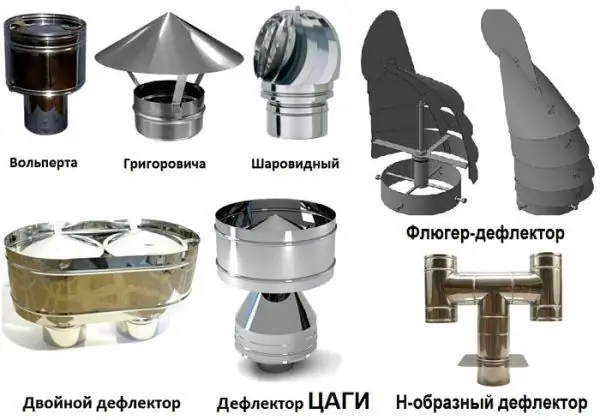
A wide variety of devices can be used to enhance traction.
Electric smoke exhausters
Currently, special devices are becoming widespread that maintain optimal traction in an automatic mode.
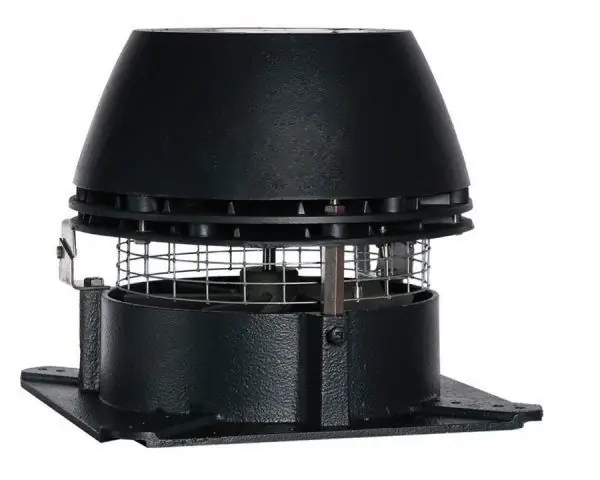
The automatic device controls the thrust based on data from the connected sensors
Such devices can be installed on chimneys of gas, solid fuel and other furnaces with a flue gas temperature of up to 800 o C. The flow rate and gas temperature is controlled based on the readings of the corresponding sensors.
DIY chimney draft amplifier
A deflector to enhance traction can be easily made independently. Consider the option of making a deflector-weather vane with your own hands. This will require the following tools and materials:
- Wooden mallet.
- Shears for cutting sheet metal.
- Roulette and metal ruler.
- Electric drill.
- Riveter.
- A set of drills for metal.
- Hacksaw for cutting metal.
- Pencil or marker for marking.
- Tailor's scissors.
- Wrenches.
- A piece of pipe, selected according to the dimensions of the chimney.
- A die to thread the rod.
- Fasteners - bolts, nuts and rivets.
- A pair of bearings for the diameter of the rod and pipe. It is preferable to use closed type maintenance-free products.
- Stainless steel sheet 0.5 mm thick.
Photo gallery: what deflectors can be made by hand
-

Size ratio for making a deflector with your own hands - All dimensions of the deflector are set relative to the diameter of the chimney pipe
-

Deflector Grigorovich - The Grigorovich deflector can be made of stainless or galvanized steel
-

Rotary deflector - The rotor deflector is more difficult to make, since there is a turbine inside it
-

Sectional deflector - The deflector consists of a body in the form of a truncated cone and an umbrella attached to it on metal paws
Step-by-step instructions for making a deflector
- Make drawings of parts and their development with reference to the real dimensions of the product.
-
According to the drawings, make patterns of parts on cardboard and cut them out with tailor's scissors.

Patterns made of cardboard Before transferring the cutting of parts to a metal sheet, they are first cut out of cardboard
- Draw the contours of the parts on a metal sheet using templates. This can be done with a marker or pencil. The sharpest contours can be obtained with aerosol dyes.
-
Using scissors for metal, cut out the unfolded parts from the sheet.

Cutting out metal parts On the applied contours, parts are cut with metal scissors
- Bend the body from the sweep, adhering to the dimensions according to the drawing. Drill rivet holes in the sheet using an electric drill. When working with stainless steel sheet, it is advisable to use drills made of hard alloy P18. At the end of the drilling, it is necessary to blunt the sharp edges on the exit side of the holes.
-
Using a riveter, blind rivet the part or manually rivet standard aluminum fasteners onto the mandrel.

Fastening the metal parts of the deflector It is most convenient to fasten metal parts with rivets, but if the appropriate tool is not at hand, bolts and nuts can be used
- Install the brackets for attaching the housing to the rod.
- Cut a thread of the required size on the rod.
- Install two bearings on the thread and secure them with nuts.
- Cut the pipe to the required length with a hacksaw for metal, blunt the sharp edges, remove burrs.
- Drill holes in the resulting part and cut a thread with a tap to fix the bearings in it.
- Using a steel strip, fabricate the support parts for installing the deflector on the pipe.
-
Perform final assembly using screw fasteners and rivets.

Deflector - TsAGI weather vane Thanks to the use of bearings fixed on a vertical rod, the weather vane smoothly turns in the direction of the wind
There are many options for the manufacture of weather vane deflectors. Properly manufactured, they reliably protect the chimney from clogging and moisture penetration. At the same time, the chimney draft is significantly improved.
Video: making a deflector with your own hands
User reviews
There are many ways to increase the draft in the chimney, you just need to correctly determine the cause of its deterioration and eliminate the shortcomings in a timely manner. Otherwise, you can only aggravate the condition of this important device. Therefore, it is better to consult with a professional or entrust the work to him.
Recommended:
How To Make A Chimney In A Bath With Your Own Hands: Scheme, Device And Calculation, Output Through The Ceiling, Insulation, Step-by-step Guide With Photos And Videos

The chimney in the bath: what is it, why is it needed, what kind of structure it has and how it is made by hand
How To Make A Speed Controller For A Grinder With Your Own Hands, How To Decrease Or Increase The Speed + Video Instructions

Speed controller and smooth start of the grinder. What unites them. How to make a device yourself
How To Make A Chimney From A Steel Pipe With Your Own Hands: Device, Installation Of A Sandwich Structure, Instructions With Photos And Videos
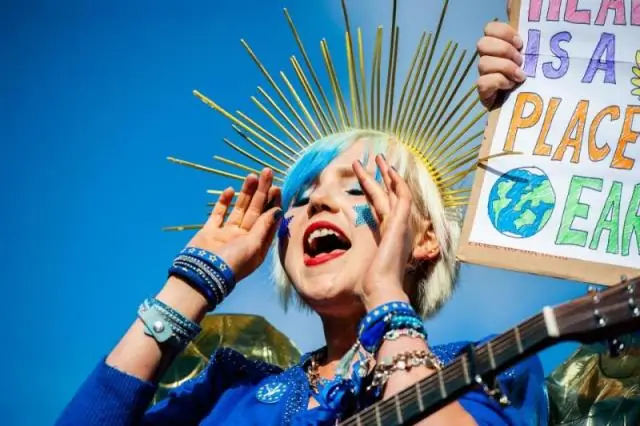
What is a steel pipe chimney, where is it used, its advantages, disadvantages and its manufacture by hand
How To Increase The Draft In The Chimney With Your Own Hands: Identifying A Defect, Ways To Eliminate It, Etc

The concept of chimney draft, what is reverse and temporary. Ways to eliminate adverse factors. We make a device with our own hands to increase the indicator
How To Properly Make A Chimney With Your Own Hands, What You Need To Consider, Including The Features Of Its Installation And Decoration

Chimney parameters and methods for their determination. The choice of material. Rules for the design of nodes for the passage through the enclosing structures and places of abutment to the roof
